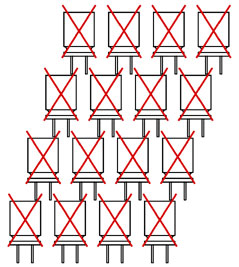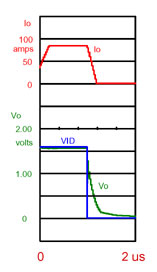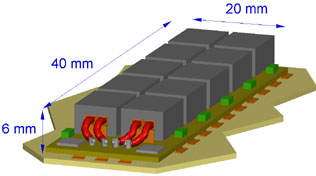
One Dyer Cemetery Road
Canton, CT 06019-2029
Phone: 860 693 1684
Fax: 860 693 1686

 Switched Current Power Converters
(PowerPoint slides as pdf)
Switched Current Power Converters
(PowerPoint slides as pdf)
The slides provide a brief
introduction to
the Switched Current Power Converter.
Revised March 13, 2006. 29 pages, 1.34 M.
Multiphase
Buck Converter
- vs - Switched Current Power Converter (pdf)
A comparison of a four phase buck
converter to the SCPC shows the major differences, including output
impedance, input power requirements, emi filtering,
input current and voltage characteristics, the magnetics and
semiconductors used, and failure
modes and effects.
Revised March 13, 2006. 19 pages, 590 k.
 Switched Current Power Converters (pdf)
Switched Current Power Converters (pdf)
The characteristics and theory of operation of
the SCPC is presented. Switched charge circuits may be added to
the SCPC to provide extremely fast and precise step voltage changes,
even with simultaneous load changes. Total charge measurement is
used, because neither current measurement nor voltage measurement is
fast enough for control purposes.
Revised March 13, 2006. 61 pages,
1.5 M.
Total Charge Measurement
and Control (pdf)
A very fast power converter
needs a very fast measurement and control. The remotely sensed
output voltage Vo of a power converter is not a suitable control input,
as it takes too long to settle. The output current is even worse,
and measuring it is horribly complicated. The solution is to
measure the total charge on the distributed capacitors in the power
train. It is very simple, very fast and unconditionally
stable. With total charge control, a very well controlled high
driving voltage overcomes the impedance of the motherboard and socket,
allowing very fast di/dt with no overshoot and a 1 us settling time,
for both rapid increases in load and load dump.
Revised April 18, 2006. 15 pages, 289 k.
Switched Current Power Converter;
Transient and Frequency
Response (SPICE Models) (pdf)
 The SCPC was modeled in SPICE
using the parasitic impedances of Intel ® VR 10.2, (except that the
bulk capacitors are not needed and were not
included). The
large-signal output impedance was modeled and graphed, as well as the
response to step load changes. The
response of the SCPC to VID change was also modeled and plotted for
several scenarios, with and without
switched charge circuits.
The SCPC was modeled in SPICE
using the parasitic impedances of Intel ® VR 10.2, (except that the
bulk capacitors are not needed and were not
included). The
large-signal output impedance was modeled and graphed, as well as the
response to step load changes. The
response of the SCPC to VID change was also modeled and plotted for
several scenarios, with and without
switched charge circuits.
Revised March 12, 2006. 50 pages,
1.55 M.
Simple Power IC (pdf)
Design of economical switching MOSFETs is key to making a practical
SCPC. A fully integrated power IC requires a complex and expensive
manufacturing process, requiring many masks, diffusions, and so
forth. The
simple power IC is based on the premise that the process for making a
discrete MOSFET can be use if all of the MOSFETs are constrained to be
the same type
except for their active area.
March 3, 2006. 10 pages, 250 k.
Saving Power by Using Switched Current
Power
Converters (pdf)
Power saving strategies and the
power usage of the Switched Current Power Converter are discussed for
various operating modes and scenarios. The greatest
opportunity for saving energy in a computer system is realized by
allowing the processor to be in a reduced power
state (or be turned off entirely) more of the time.
Revised March 12, 2006. 19 pages, 174 k.
Do Voltage and Clock Switching
Really Save
Energy? (pdf)
A processor uses less power if
it is operated at a lower voltage and a slower clock rate. But
does this really save energy? If a processor turns on, runs a specific
task that is a fixed number of clock cycles, then turns off, the energy
consumption is nearly the same at any voltage and clock speed!
Revised March 13, 2006. 5 pages, 38 k.
Dynamic Power Links (pdf)
A random search of the WWW
turned up some odds and ends on the trends in dynamic power
management. The notes contain a number of interesting links.
September 20, 2005. 10 pages, 175 k.
Coaxial Push Pull Transformers (pdf)
The coaxial push pull
transformer uses the same magnetic core structures as the flat matrix
transformer, and shares its characteristic low profile and excellent
thermal dissipation. A new winding design using a coaxial
arrangement between the primary and
the secondary windings has near ideal coupling and near zero leakage
inductance. The
absence of multiple layers of copper eliminates many of the more
troublesome high frequency effects.
The coaxial push pull transformer is ideal for a "dc-dc
transformer". A variant has a turns ration
that can be varied electronically, so the "dc-dc transformer" can have
a precise output voltage even with
input and load regulation.
Revised March 14, 2006. 26 pages, 227 k.